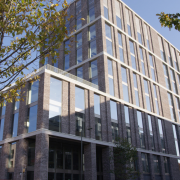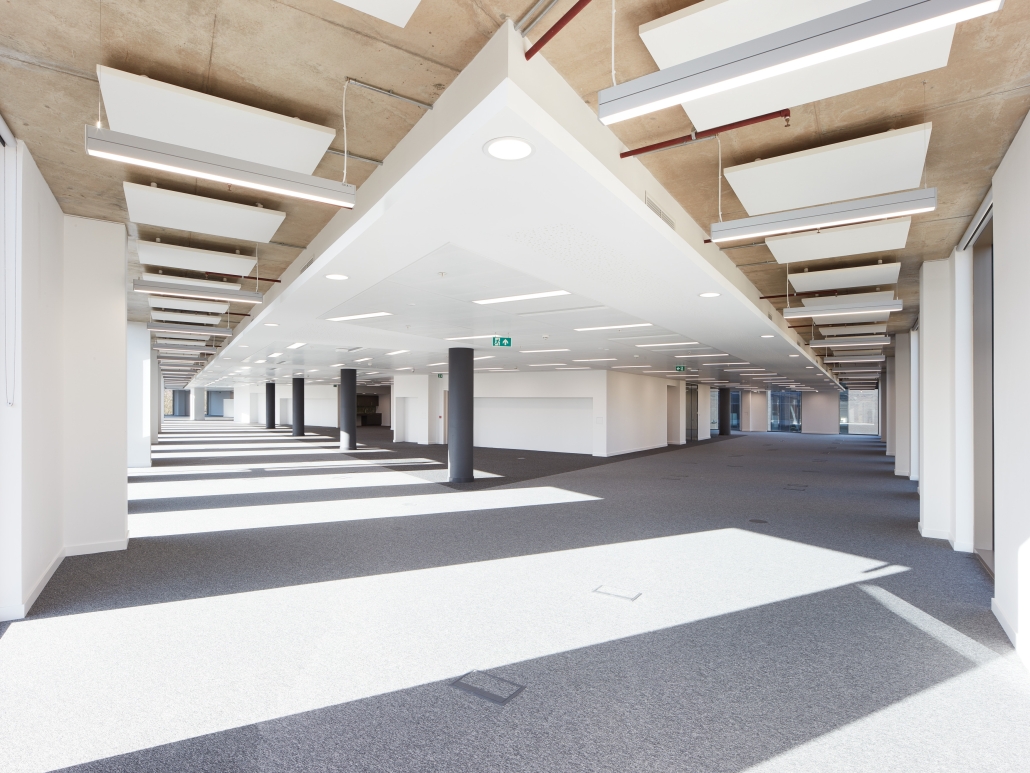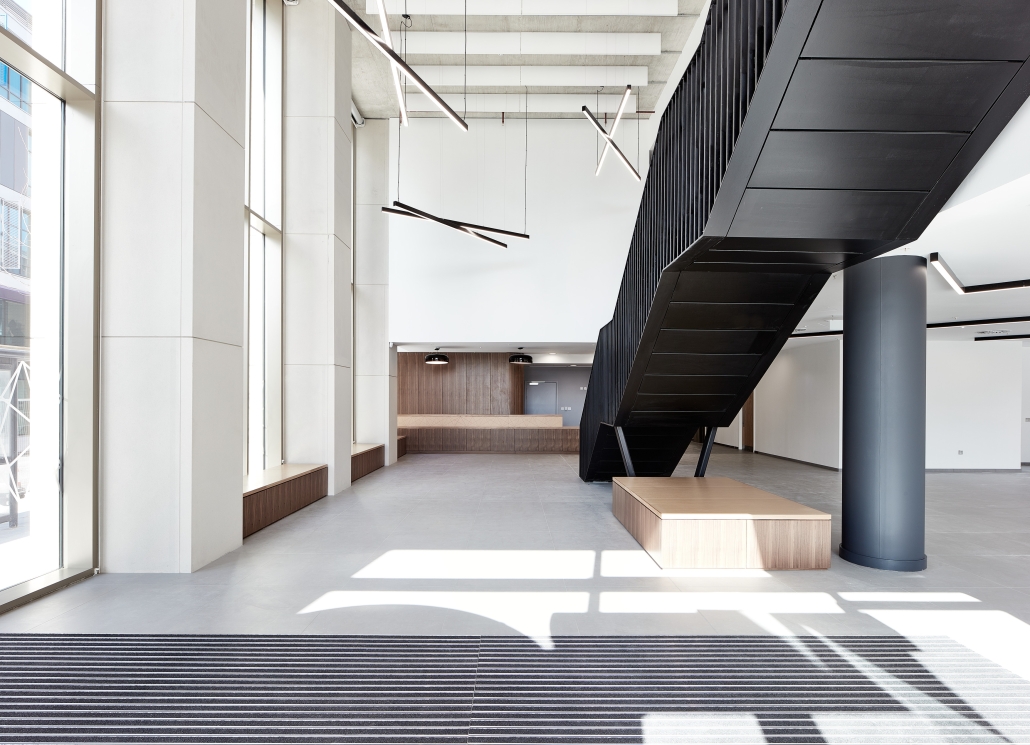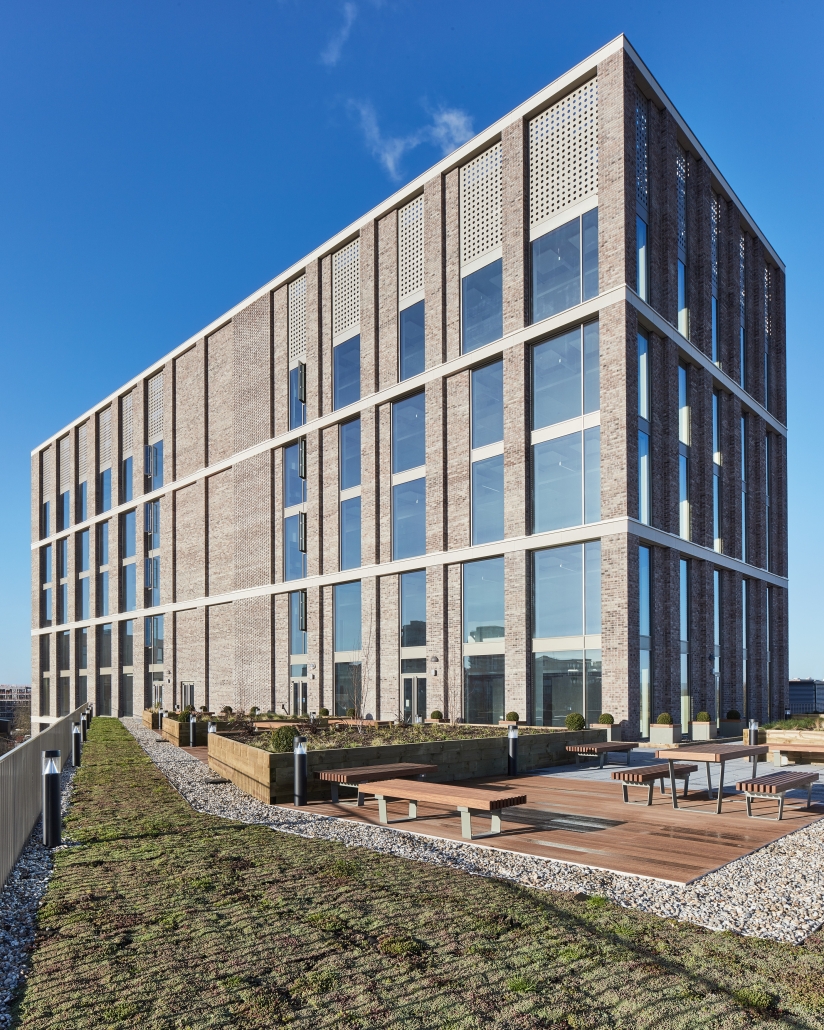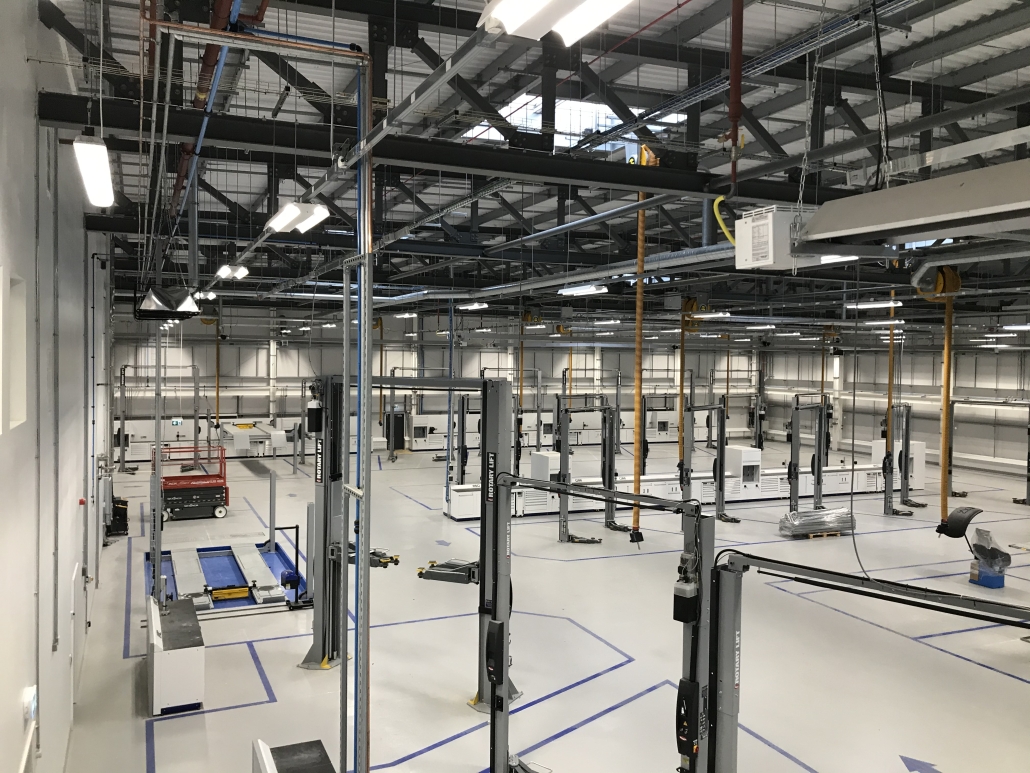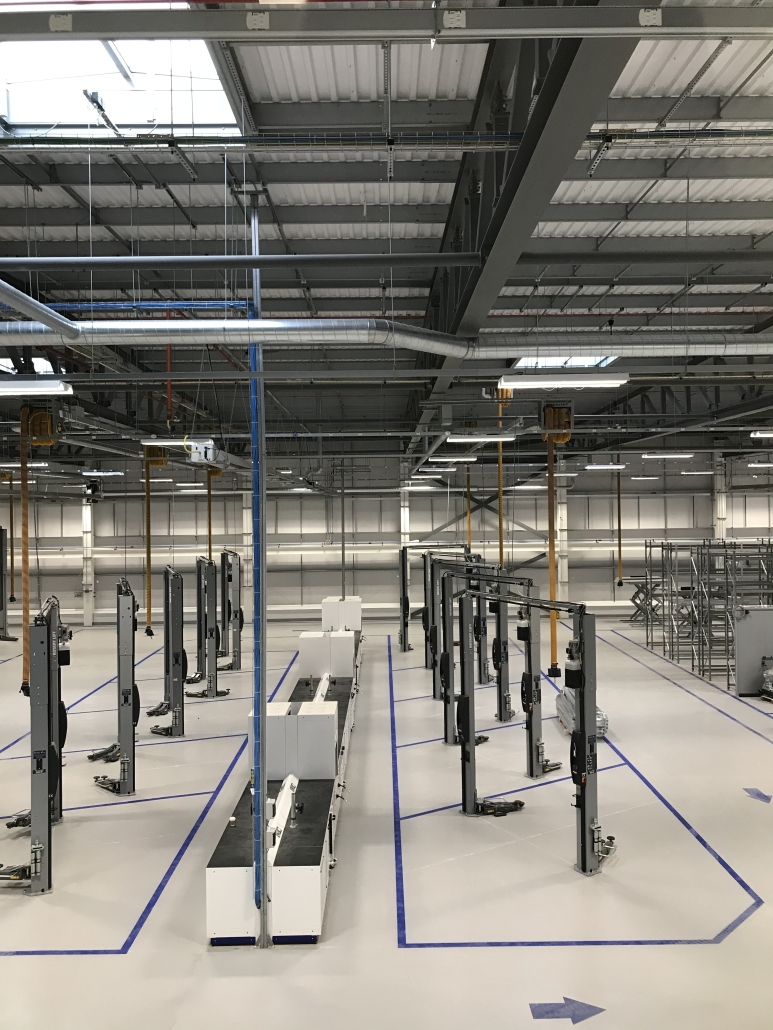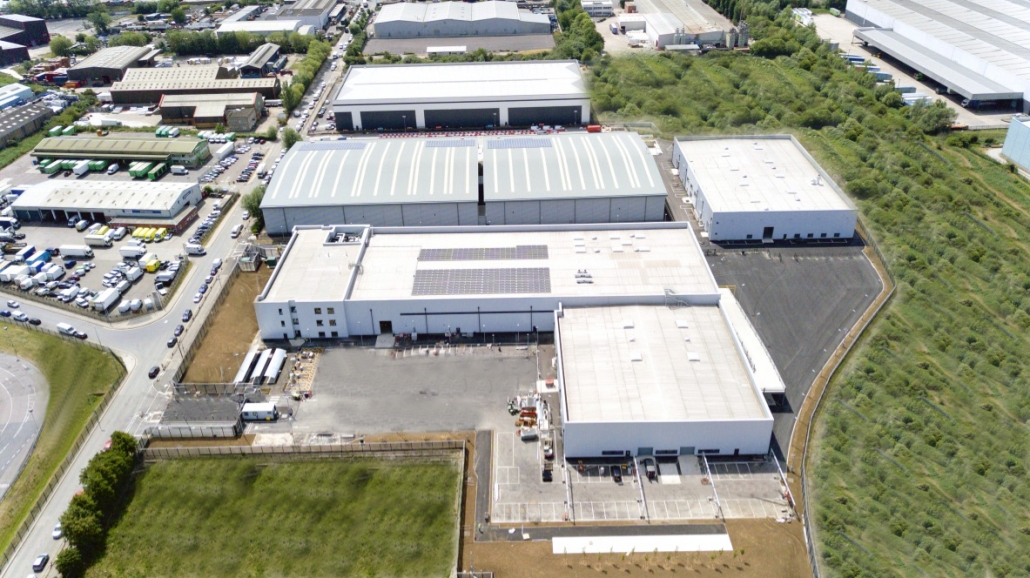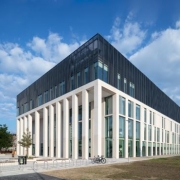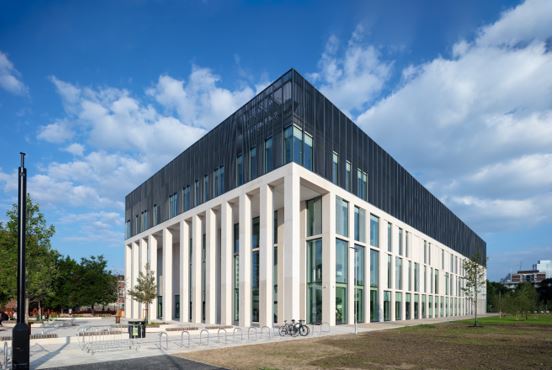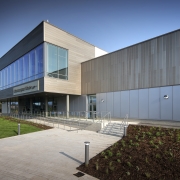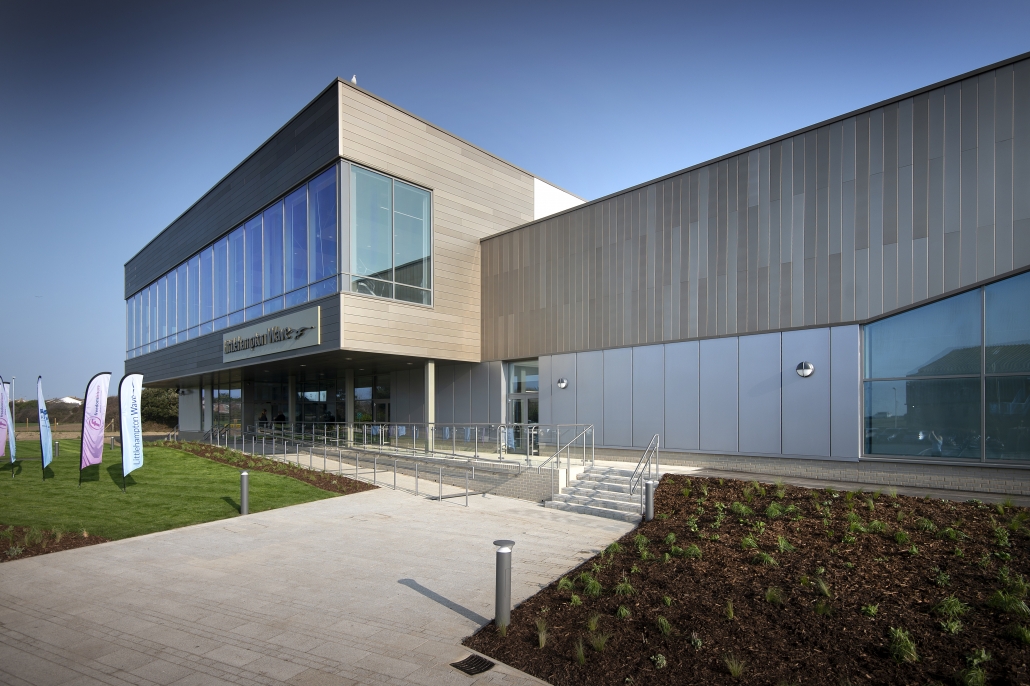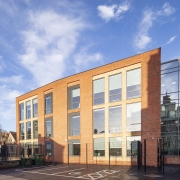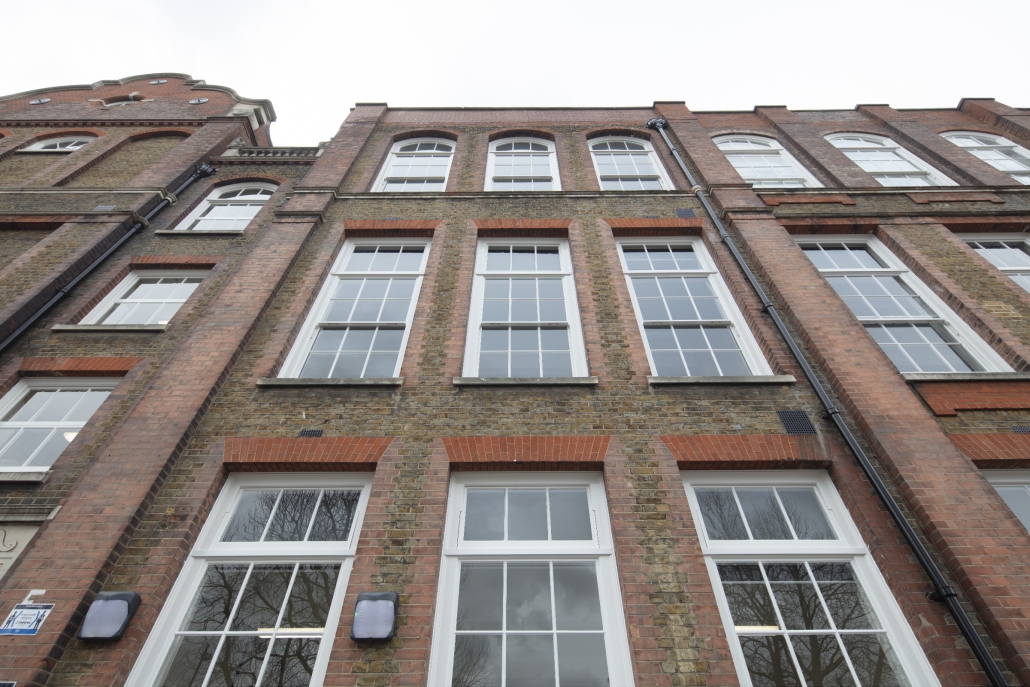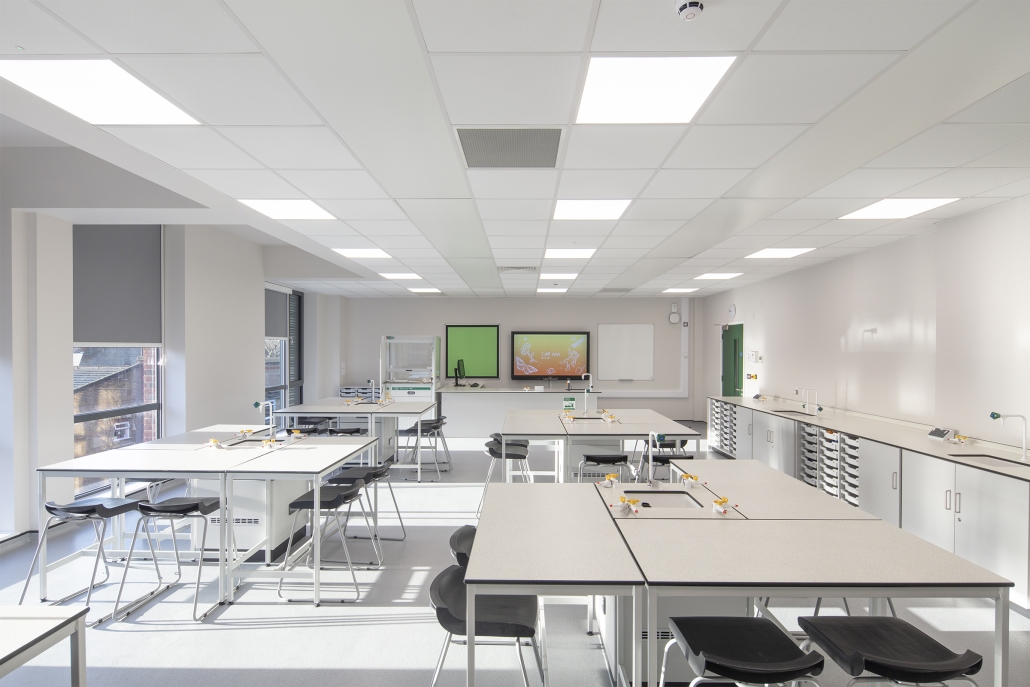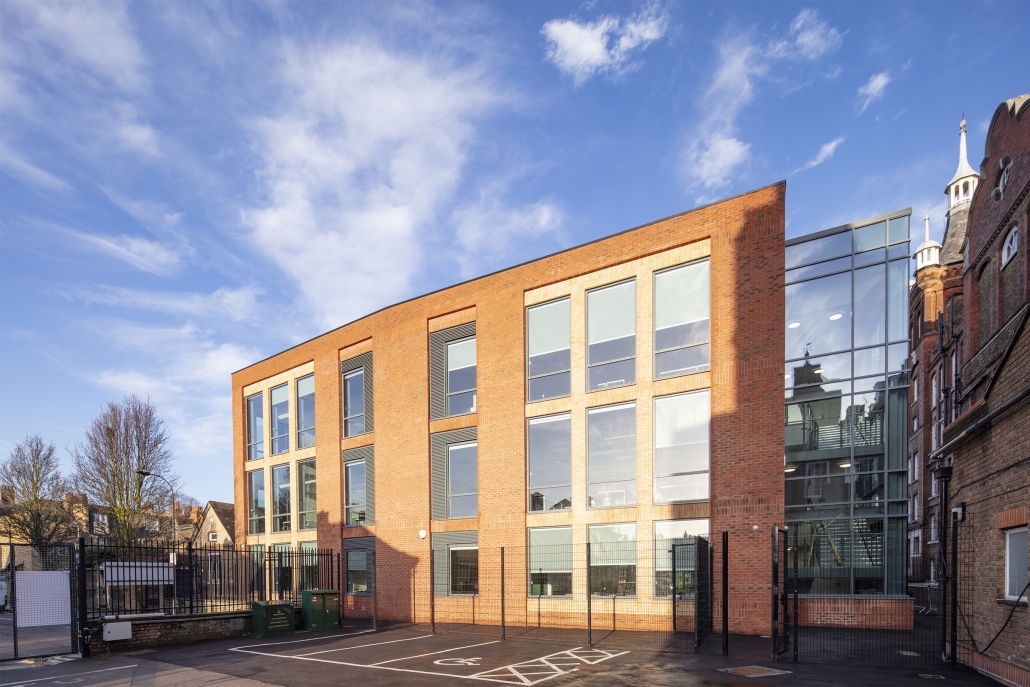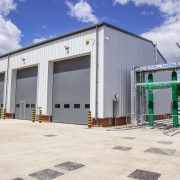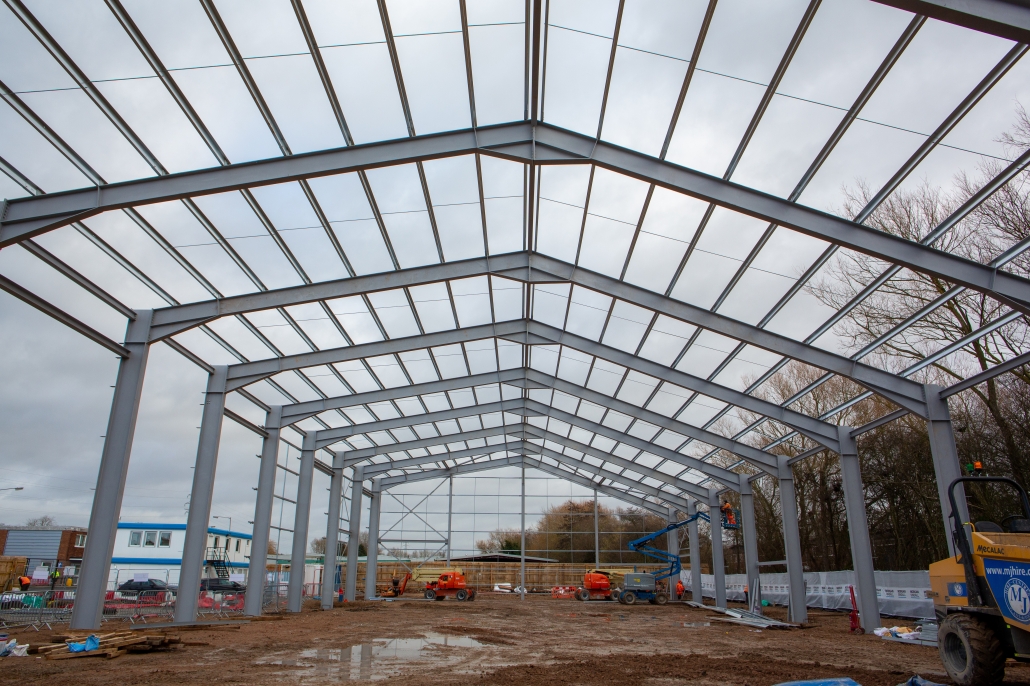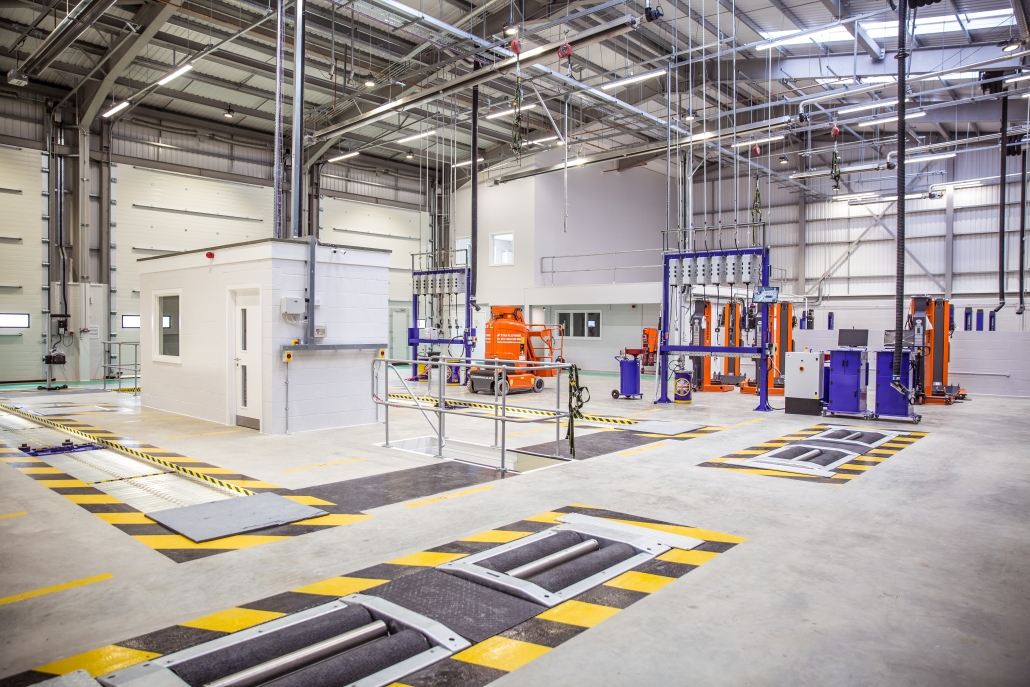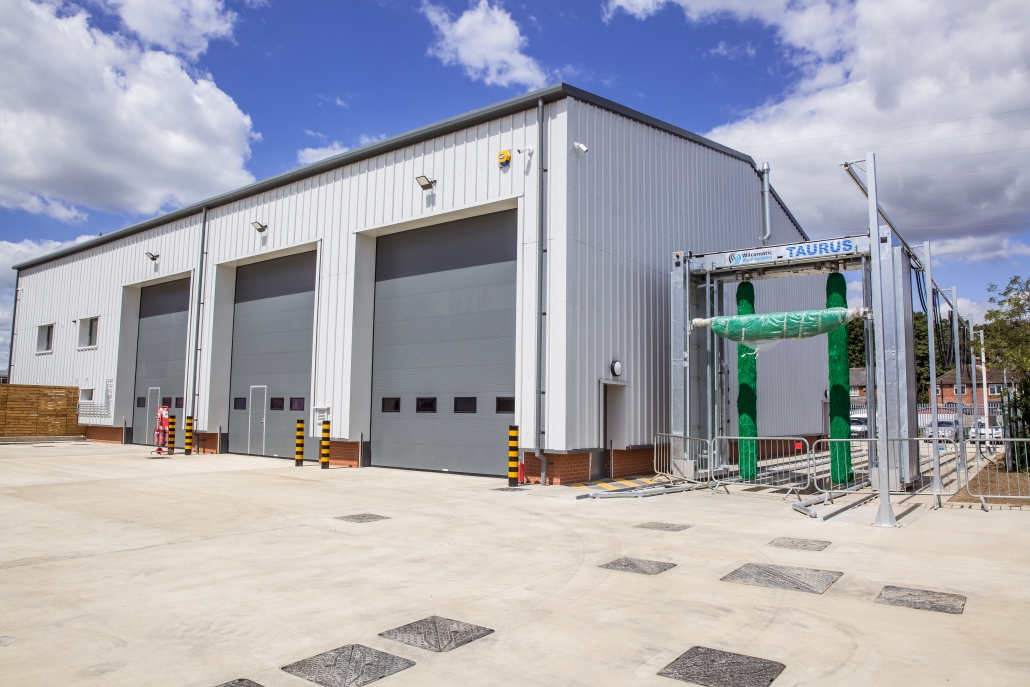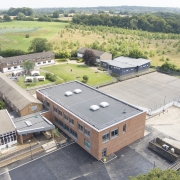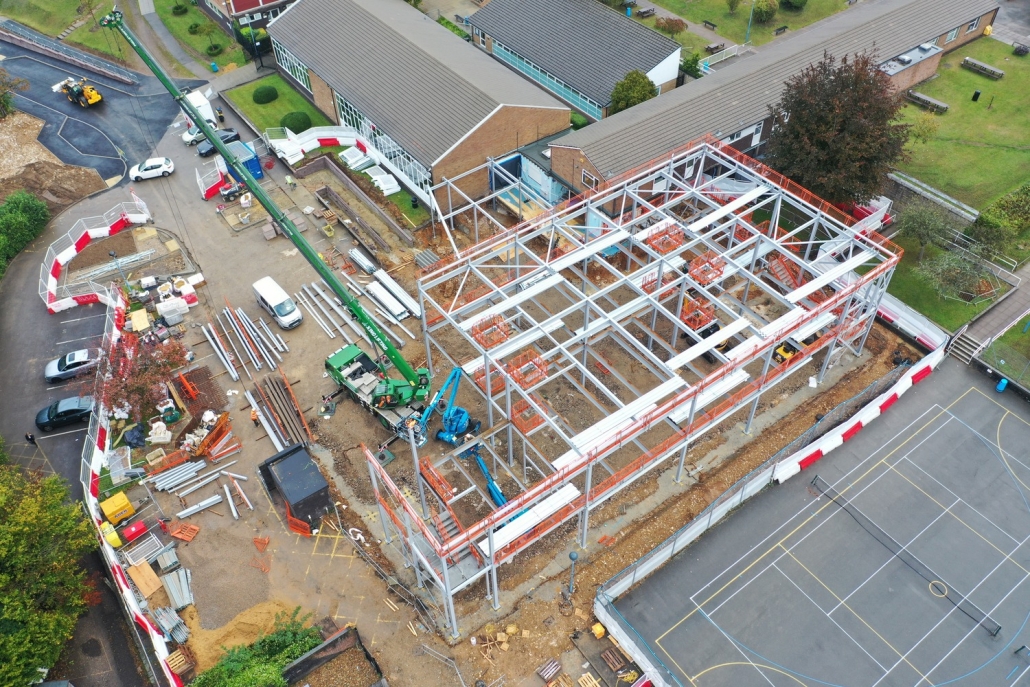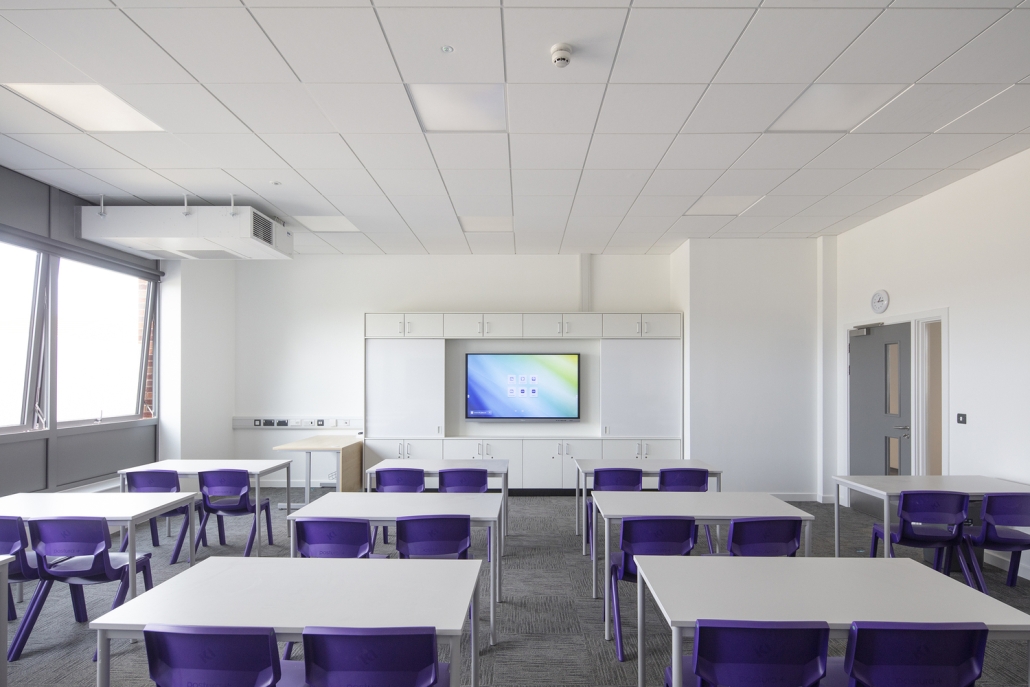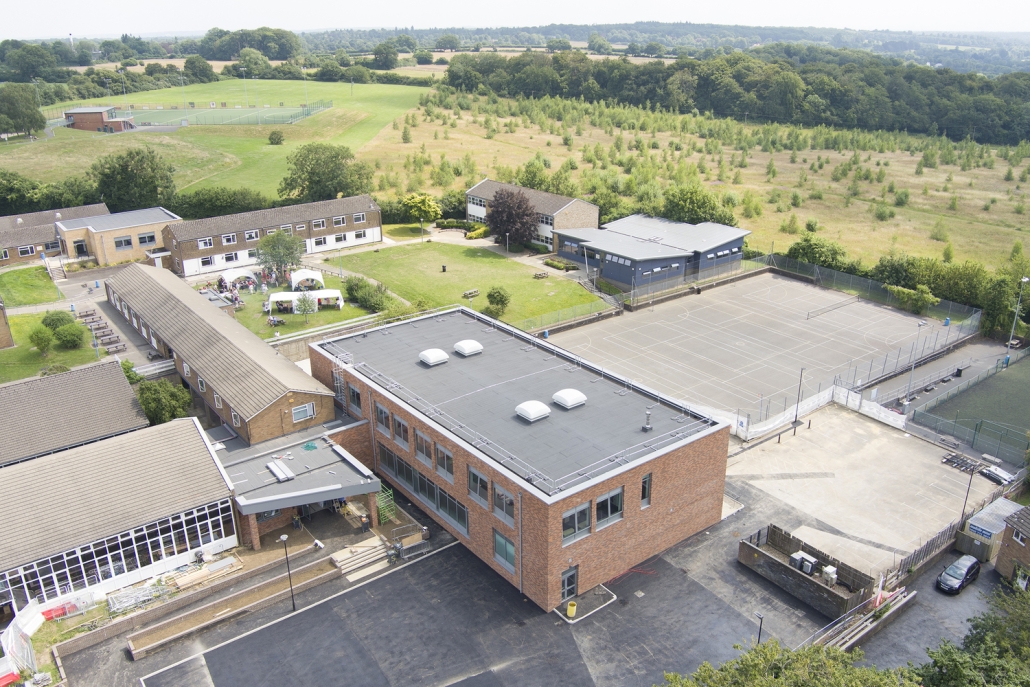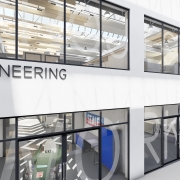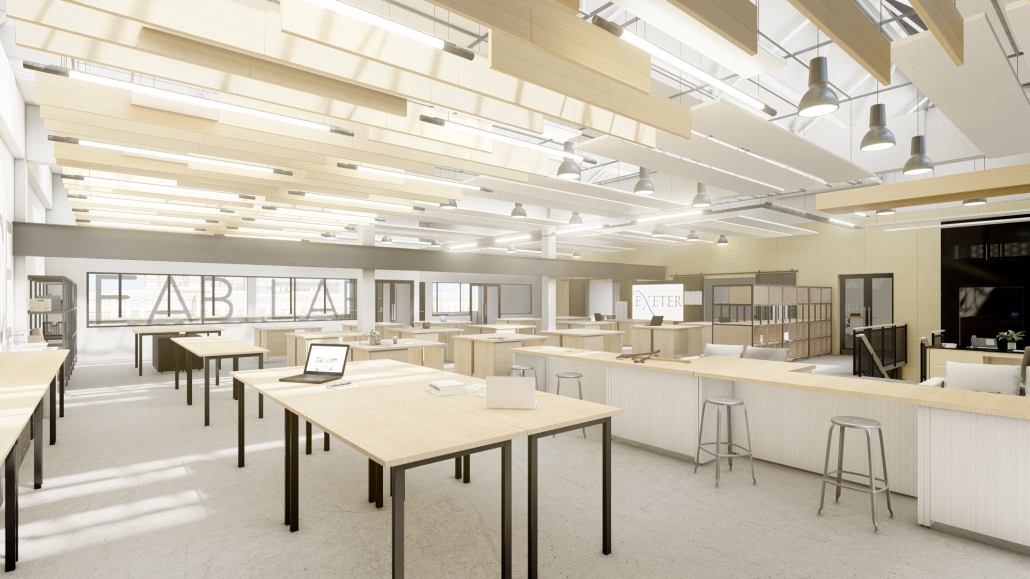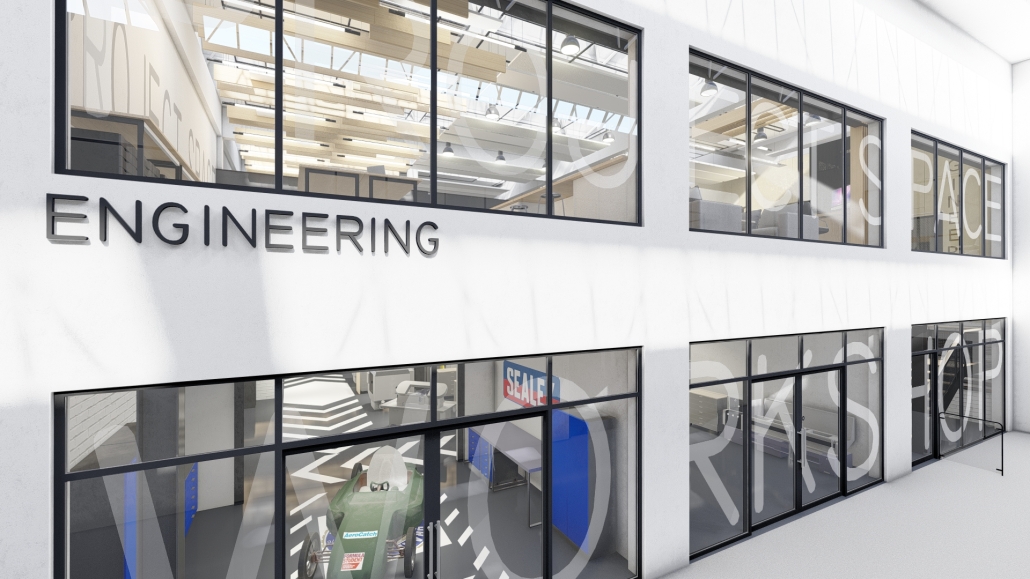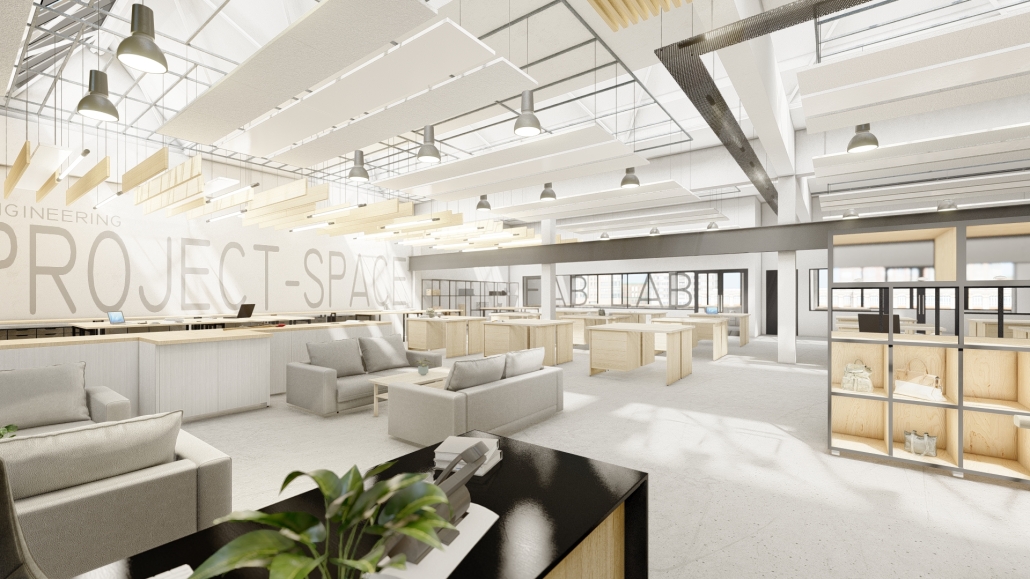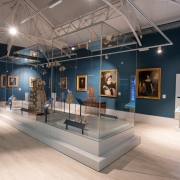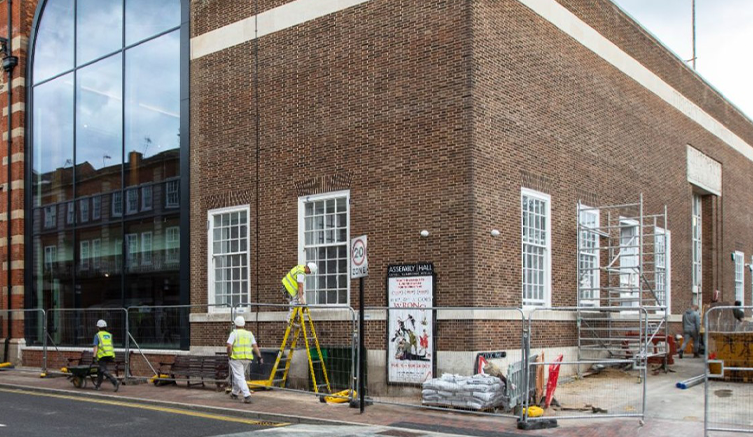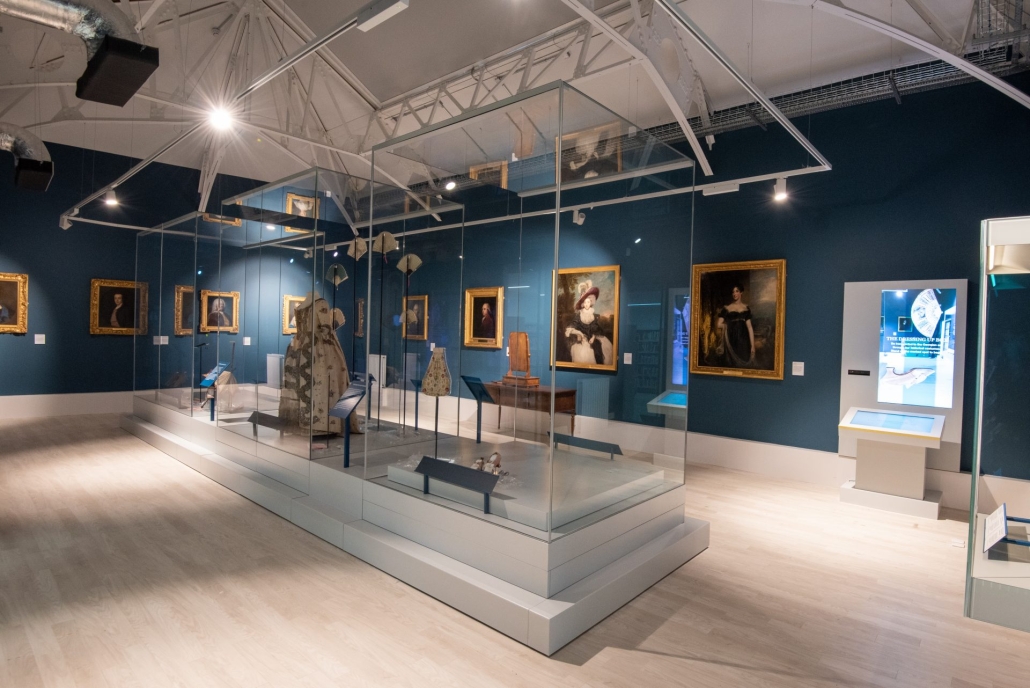Extreme Photonics Applications Centre, Harwell Science and Innovation Campus
The Extreme Photonics Applications Centre (EPAC) building is a new purpose-designed facility that will house cutting-edge equipment required for a unique, state-of-the-art high power / high repetition rate laser system.
The project is a partnership between UKRI, MoD, academia and industry. It brings together world-leading interdisciplinary expertise to develop and apply novel, laser based, non-conventional accelerators and particle sources which have unique properties. It is hoped to produce scientific breakthroughs and stimulate new solutions to challenging problems to help advance UK science and technology, helping to keep us safer, improve our healthcare and support a cleaner, more productive economy.
The Challenge
The science and technological application required us to place 7500cu metres of a specially designed low carbon concrete mix to create 3 reinforced concrete ‘laser target areas’ as a homogenous ‘crack-free’ structure.
The Solution
To achieve the ‘crack-free’ structure required the advice of one of the best structural minds in the world combined with technical expertise from renowned locally based ready mix concrete supplier. The structural solution was successfully delivered hailing it as one of the most important structures in Europe outside of the nuclear industry.
The Results
The project achieved a 48% (or 1372.5 tonnes) carbon reduction using structural concrete with a composition of 75% Ground Granulated Blast Furnace Slag (GGBS) and slag cement replacement (blast furnace bi-product) in place of 100% Portland Cement. The concrete design was based on its radiation shielding properties, high density aggregates and reduced cement content to reduce the risk of thermal cracks. Specifying this concrete mix enabled the site team to maintain control of the curing temperature to ensure minimal cracking and achieve the specified oven dry density for shielding purposes.
Redefining the Boundaries of Science and Discovery at Harwell Campus
Apprentices
SME Spend
Added Value
Client Satisfaction
Health & Safety
Client Testimonials
Contractor Performance | Commitments
Fair
All payments in accordance with the fair payment charter.
Safe
Zero RIDDORs
Legacy
450.8 apprentice training weeks, 80 trainee weeks, 292.3 graduate trainee weeks.
Aftercare
Client provided an 8/10 score for the buildings building’s future maintenance and running costs, including energy efficiency.
Sustainability
By using 75% GGBS the project achieved a 48% carbon saving. This equates to 1372.5 tonnes of carbon (in comparison with using 100% Portland Cement).
SCF Framework Manager
James Wright
Email: james.wright@hantsgov.uk
Phone: 07761 330560
Contractor Framework Manager
David Chambers
Email: david.chambers@macegroup.com
Phone: 07789 514895
Colindale HQ
Construction of a new £36 million office building providing bespoke office accommodation for London Borough of Barnet. The project forms part of the Colindale regeneration programme. The new development is a nine-story building with a recreational terrace area on the 4th floor and provides a modern working environment for up to 1,400 people, including office spaces as well as a cafe on the ground floor. The new facility supports the London Borough of Barnet in working closer with the community.
The Challenge
Following PCSA appointment, London Borough of Barnet required to increase the use of the building to include additional community facilities like social services, business innovation hub, café and public conference suite – all whilst maintaining budget.
The Solution
Working with the architect, Hawkins Brown, we adapted the previous scheme design and incorporated an additional floor space to house the extra facilities. The redesign process required building shape and structural changes and extension of building services. The end users were consulted and engaged throughout the process to ensure group consensus. By working with Price & Myers, structural engineers, we redesigned the underground drainage connections which was tunnelled and avoided costly and disruptive above ground work. This removed the connection from the critical path and reduced programme risks considerably.
The Results
Despite having to extensively redesign, the preconstruction period was maintained and through early engagements with supply chain partners and through collaborative design and planning workshops, value engineering options were identified, resulting in a new enhanced scheme delivered within budget.
Apprentices
SME Spend
Added Value
Client Satisfaction
Contractor Performance | Commitments
Fair
Payment periods were agreed at preconstruction and adhered to.
Sustainability
Over 60% of supply chain were within 30 miles of the project, resulting in £18m spent locally. The project achieved BREEAM Very Good and incorporated energy saving design efficiencies, reducing running cost by £1m a year.
Aftercare
The Project Manager remained on site four weeks post completion and aftercare was managed in-house by our Facilities Management team.
Legacy
The team exceeded targets by 200% for work placements for under 16 years and through engagements with Barnet and Southgate College, 12 placements were given to their students. In addition, we also held bricklaying competition, enabling students from the college to learn new skills and gain support from site managers and supply chain directly.
Safe
The team held two Safety Stand Down days and 221 operatives participated. The Intervention Workshop encouraged better communication and buy-in from our supply chain partners in the management of health and safety which helped the team achieve 43 on their last CCS visit.
SCF Framework Manager
James Wright
Email: james.wright@hants.gov.uk
Phone: : 07761 330560
Contractor Framework Manager
Angela Purse
Email: angela.purse@gallifordtry.co.uk
Phone: 07593 561855
Belvedere Warehouse
Construction of a new secure warehouse facility; comprising two separate building structures. Building one provides office accommodation facilities over three levels, a warehouse facility and two storey specialist storage facility encompassing double-volume intelligent storage equipment, as well as a number of cold hold refrigeration storage units. Building two is a standalone vehicle maintenance workshop, which contains specialist vehicle testing machinery and servicing equipment.
The Challenge
Following site surveys and results from investigative reports, the ground was found to be significantly contaminated from previous use of the site. Despite being a construct only contract, we helped the client through the design process, finding most cost efficient solutions that maximised reuse.
The Solution
We had to raise the site ground level as a result of site investigation and thus required changes to the designs. Remediation works were needed to manage the contamination and included excavation of materials, mixing it with clean / inert materials to reduce contaminations levels and reusing on site. Under strict controls, the works were fully compliant to ensure safety of the workforce.
We adopted an early warning process using the NEC proforma and through working collaboratively with the Employers Agent and our groundworker and M&E supply chain partners, we managed to develop designs which saved the client money, like rationalising the pile and mat make-up and size and installation methodology, which avoided contamination arisings. Substantial earthworks movement were closely managed with commercial neighbours and residents nearby through daily liaison and by regular updates on our site information board.
The Results
The value engineering designs saved the client over £1.5m. One of those included using a sleeved piling system with reduced pile diameters that avoided contaminated arisings saving both time and £540k in disposal costs.
SME Spend
Added Value
Client Satisfaction
Contractor Performance | Commitments
Sustainability
In addition to achieving 100% recycling during the groundworks phase, we also installed and maintained bird feeders and planters throughout the project to encourage biodiversity.
Fair
25% procurement was with small businesses and payment periods were kept to throughout the project.
Safe
Despite the groundwork and logistic challenges, there were zero complaints and through innovative ideas like using a ‘Thumbs Up’ sticker to denote plant safety, the team scored an average of 44 on their CCS visits.
Legacy
5 work experience placements were offered to students at London South East. Additionally, a graduate successfully completed her apprenticeship and is currently employed by GT as a Trainee Technician. In addition, the team donated 60 biscuit boxes to Queen Mary’s Hospital to thank the nurses, doctors and staff for their dedication, helping the community through the Covid pandemic.
Aftercare
An Operations Manager remained on site for six weeks post completion to ensure that end users were satisfied and looked after. Our Facilities Management team managed after care for 12 months.
SCF Framework Manager
James Wright
Email: james.wright@hants.gov.uk
Phone: : 07761 330560
Contractor Framework Manager
Angela Purse
Email: angela.purse@gallifordtry.co.uk
Phone: 07593 561855
City of London Shoreditch Academy and Hackney Britannia Leisure Centre
New 6FE secondary school for 940 pupils and 200 6th form. Roof top sports pitch and playground. BREAAM Outstanding at design stage. High environmental performance.
New 4-storey Britannia Leisure Centre with mix of single, double and triple height spaces. Six-lane 25m main pool and 20m training both with moveable floors and leisure features including 3-storey flume. Café and toilets. Indoor 6 court sports hall. Creche and soft play area. Sauna and steam room. Fitness suite (spin studio and 2 exercise studios). Four squash courts. Two rooftop 5-a-side pitches and 2 rooftop tennis courts.
The Challenge
Shoreditch Academy: As the existing Britannia Leisure Centre remained open throughout construction, customer access into the leisure centre needed to be modified to facilitate the COLASP building which was almost the footprint of the existing carpark and therefore logistically challenging.
Leisure Centre: Externally, we focused on a design solution to encourage the local community to participate in sports and lead a more active lifestyle. As such, the cellular changing accommodation was positioned in the centre of the building, with the pool-halls and other sports spaces wrapped around the perimeter. This produced an elevated, animated building that entices the public into the facility.
Thames Water sewer: Construction of the leisure centre was complicated by the presence of an existing large diameter Thames Water storm relief sewer that runs diagonally across the site at a depth of 14m. This sewer has an exclusion zone of 3m either side and above it where no new construction is allowed. The building is on a tight footprint and the leisure activity zones are ‘stacked’ vertically which created some interesting challenges in structural stability and vibration control. Spanning 9m over the sewer and due to the diagonal alignment, equates to some 14m on grid, this alone brings significant construction challenges. The site also directly sits on the position of a vertical access shaft which gave access to the sewer for maintenance and emergency escape purposes.
The Solution
Shoreditch Academy: We designed an innovative ramped solution into the top floor of the Leisure Centre building to allow it to remain open while the new school was built. We fixed transport routes around the whole site to manage traffic and deliveries. There was a cycle superhighway adjacent to our site, which required collaboration with the highways team. The proposed route for Crossrail 2 was also located directly underneath the new Academy, so the building design needed to be considered due to strict loading restrictions imposed by Crossrail.
We designed a unique groundworks solution to incorporate the temporary sheet piling into the permanent structure at basement level, creating an extremely cost-effective solution for the project. The precast cladding was then selected as it required no scaffolding and cut down on noise and vibration on vehicle deliveries to the site.
The façade was also load-bearing and allowed the design of the concrete framed structure to be simplified and fast erection on site while minimising construction site area. We even designed the City of London logo onto the facades via a patterned concrete finish which was then installed along with all other panels. The future Crossrail tunnels, size of the building and constrained nature of the site required an innovative approach. The building footprint was kept as small as possible to maximise the playground areas, taking advantage of the existing topography to create an amphitheatre playground.
Leisure Centre: Due to the complexity of the stacked leisure centre we had to keep the sports hall free of columns, and to bridge over the pool areas a complicated steel truss arrangement was needed. Spanning over 10m in height and 50m in length, the spine of the building spans 3 floors. Due to these structural intricacies, this was built on-site then lifted into place with two 500 tonne cranes in a tandem crane lift. This was an innovative and important project milestone for the build, which was completed safely and successfully.
We developed a team of specialist engineers whose knowledge and input enabled us to create a safe, on time and to budget build. As an example, the main 25m swimming-pool hall is double-height, and the leisure pool hall is triple height. Each of these pool spaces contains warm, moist air which is under positive pressure. Cooler spaces such as the sports hall and fitness gym are positioned over the pool-halls therefore the environmental separation between each of these spaces was a key construction challenge. To help deliver this environmental control we involved a specialist mechanical engineer with a focus on finite engineering. This ensured we maintained the continuity and integrity of the vapour control layer both vertically and horizontally within the building, preventing pool-hall air migrating through the building envelope, preventing it condensing on any cooler surfaces or spaces. Maintaining the continuity of the vapour control layer and insulation performance was particularly important for our roof-top pitches. We knew the importance of having an air-tight vapour control layer that was chlorine resistant for the longevity and overall safety of the build.
Thames Water sewer: We worked with Buro Happold and Thames Water to overcome the main risks of working over the sewer. This involved developing a working / construction methodology of preventing the sewer from trying to pop out of the ground due to buoyancy when it was empty or bursting under 14m head of water pressure when it became full. One of the main the concerns was that by excavating over the sewer to form the basement areas and pool shells, we would be effectively reducing the weight of the soil over the pipe, increasing the risks associated with buoyancy or bursting. Early involvement commissioned a detailed line and level survey to ascertain the precise depth and alignment of the sewer pipe, this led to greater confidence and understanding of design parameters and restrictions.
The Results
Shoreditch Academy: The school was originally due to open in September 2021; however, we were able to hand over the building for the school to occupy earlier than planned in June 2021 to use for their final school term and allow the year 11 pupils to carry out their final exams in their new school.
Leisure Centre: With our attention to detail and meticulous checking systems we are set to achieve BREEAM Excellent. The building’s energy design philosophy was to connect into the future district heating system which was being provided as part of the redevelopment of the Colville Estate.
To enable this to occur a temporary energy centre serving both the leisure centre and school, was installed and removed once the permanent connection to the energy centre was installed. Our district heating system and the overall design compliments the energy targets established in the New London Plan, so all equipment installed is energy efficient.
As an example, we use low energy fans to minimise energy consumption and have PV panels on the roof that supports our on-site sustainability strategy. Supporting our sustainability goals, we took advantage of the TfL CS1 main cycle superhighway which was adjacent to the project and were the first contractor to adopt a carbon neutral innovation of using Cargo Bikes for plant hire and small deliveries. Almost 500 residents can see the site, so we looked for innovative solutions to flood lighting and became the first constriction company to use hydrogen flood lights which helps reduce excessive noise.
Thames Water sewer: Once we knew the exact positioning of the sewer we developed a detailed construction methodology, working with Thames Water to agree how the works would be constructed. This led to greater cost and programme certainty and the removal of the substantial provisional sums associated with the identified risks.
Apprentices
SME Spend
Added Value
Client Satisfaction
Client Testimonials
Contractor Performance | Commitments
Legacy
Winner of Building’s Award for Delivering Social Value
Hackney’s Apprentice Employer of the Year
Hosted a Wheels for Wellbeing best practice site visit as part of ongoing commitment with TfL and Streetscene to ensure the site boundary was easily accessible for all pedestrian users. Wheels for Wellbeing focus is wheelchair cycling and ensuring cycle lanes are adequate to allow inclusion for all.
Project team hosted local forums and drop-in sessions at 5 local schools in advance of works starting so they could understand the logistics and opportunities for schools engagement as well as local residents’ forum.
Partnership created with Shoreditch Trust addressing inequality and supporting people who are facing life and health problems. This included sponsorship of an Elders Feast.
Hosted CIOB virtual site tours during Covid 19 pandemic to inspire more people into construction
Sponsored Hackney Council’s virtual quiz night raising money for Hackney Foodbank
Hosted two visits from 9 SEND students to aid their transition from their old school site to the new constructed school
Hosted two site visits for K10 (local shared apprenticeship provider) for 27 students to give them much needed experience resulting in 6 work experience placements
Attended Women in Construction career seminar, speed interviews and mentoring programme
Attended a number of Hackney Works initiatives supporting local residents finding work
Created two “Paws Stations” for local daily dog walkers against the site hoarding
161 beneficiaries
64 new jobs created (39 previously unemployed and 19 live in Borough of Hackney)
34 Apprentices – 8 lived in Hackney, 18 enrolled in new apprenticeships on this project and 9 now directly employed by the company they worked for
1,096 trainee weeks
1001+ student engagement events
Schools engagement: xx students
£48,500 donations to charity
822 volunteer hours
47 No of SMEs
£2.11 average LM3
£78m social value created
Sustainability
97% waste diverted from landfill
100% timber responsibly sourced
BREEAM Outstanding
Natural ventilation and user controls maximisedTrialled cargo bike deliveries on the project making full use of TfL’s Cycle Super Highway adjacent to the project to capture industry best practice of zero emissions method of transport and resulting in 17.1kg CO2/km saving per week. We are one of the only construction sites using this type of delivery and installed a cargo bikes loading area – the first in the country!
First use of hydrogen flood lights in construction
110 trees planted doubling the previous number
Wood chippings from removed trees retained by Hackney Council’s ground maintenance team and felled trees donated to Shoreditch Adventure Playground as climbing frames and seating
Reusable water bottles which can be clipped to a belt issued to all site operatives
Safe
CCS Score 45/45
Collaborated with TfL’s Cycle Super Highway and Hackney Council Street scene by taking part in an environmental walk to agree construction logistics, review traffic routes and ensure cyclists enjoyed passing the project throughout construction. All traffic Marshalls completed TfL’s Elite Marshal training.
Nominated for TfL Transport Awards through collaboration with TfL and Hackney Highways team
Aftercare
Soft landings for handover
Dedicated Morgan Sindall point of contact
On-line portal for notifying any defects with 3 priority categories for response times
Fair
100% payment within 30 days terms
SCF Framework Manager
James Wright
Email: james.wright@hants.gov.uk
Phone: 07761 330560
Contractor Framework Manager
Alan Smedley
Email: alan.smedley@morgansindall.com
Phone: 07967 686066
Littlehampton Leisure Centre
Sussex
The Challenge
The replacement leisure centre was built on the same site as the existing leisure centre, which meant one of the biggest challenges was ensuring that there was minimal disruption to the leisure centres operations.
The Solution
To minimise disruption to leisure centre members, the construction was phased, and the new Leisure centre was constructed before the existing building was demolished.
The new leisure centre comprises wet & dry facilities including 8 lane 25m swimming pool, 4 court sports hall, 80-85 station gym, studio capacity of 50 with flexibility and a learner swimming pool.
The Results
Littlehampton was opened on time and to budget with a high standard of finish, exceeding expectations of customers and Freedom Leisure who are responsible for managing the leisure centre in partnership with Arun District Council.
The project was shortlisted for two LABC Regional Building Excellence Awards 2020
1) Best Public Service or Educational Building and
2) Best Large Commercial Project in the LABC Regional Building Excellence
Once opened to the public, membership applications increased c200% outperforming forecasted targets.
Apprentices
SME Spend
Added Value
Client Satisfaction
Contractor Performance | Commitments
Fair
99% of regular payment periods did not exceed 30 days
Sustainability
97% of waste was diverted from landfill
Safe
Zero harm
Legacy
Local work placements, trainee and graduate placements and apprenticeships, along with creating new jobs in the local area.
Aftercare
Handover & Aftercare Contractor Promise
SCF Framework Manager
Contractor Framework Manager
Guy Dawes
Email: guy.dawes@willmottdixon.co.uk
Phone: 07989179444
Fulham College Boys’ School, London
Major renovation of a live secondary school, enhancing teaching provision for its transition to a Science, Technology, Engineering and Mathematics (STEM) specialist Academy.
The Challenge
Undertaking major renovation works within a live secondary school, scheduled over three phases of works.
Phase 1: The transformation of Block L (the existing drama building) for use as the site team’s welfare and site offices; internal reconfiguration of the second floor of the Childerly Building providing an additional classroom; provision of 3 working labs and 2 standard classrooms.
Phase 2: Demolition and subsequent construction of a two-storey, steel framed science block providing six new teaching labs. The building includes a green roof, PV panels and attenuation tank.
Phase 3: The extensive refurbishment of the Grade II listed Kingwood Building including asbestos removal, MEPH systems, window replacement, decoration and carpentry works.
The Solution
It was recommended to the client that Block L (which was due to be demolished) be utilised as the site office and canteen space. This not only saved the project money in site setup costs and omission of the Block L demolition works from the scope of works, but furthermore, the making good of the building provided the school with a new space for music classes.
With three separate handovers, it was imperative that a good relationship was maintained with the school staff. Consideration and understanding were incorporated into the safe planning of works and scheduling of deliveries to allow the live school to continue to operate. The use of temporary modular classrooms accommodated students away from the works thereby ensuring minimal disruption to the overall learning environment.
–
The Results
Three successful handovers to a delighted client, helping to realise the school’s transition into a specialist STEM Academy. The first phase was completed on time, the second phase was handed over two weeks earlier than expected, and the third phase of works was also completed on time.
Apprentices
SME Spend
Added Value
Client Satisfaction
Client Testimonials
Contractor Performance | Commitments
Fair
100% payment within 30 days terms
Sustainability
91% waste diverted from landfill
100% timber responsibly sourced
BREEAM Very Good
Safe
Zero RIDDORs
CCS Score 43/45 nominated for 2020 Award
Legacy
14 apprenticeships, 6 of which were new jobs created
7 work experience placements
272 Trainee weeks
Schools engagement: 361 pupils
Aftercare
Soft landings for handover
Dedicated Morgan Sindall point of contact
On-line portal for notifying any defects with 3 priority categories for response times
SCF Framework Manager
James Wright
Email: james.wright@hants.gov.uk
Phone: 07761 330560
Contractor Framework Manager
Alan Smedley
Email: alan.smedley@morgansindall.com
Phone: 07967 686066
Pembroke Road Waste Transfer Centre
Buckinghamshire Council’s existing waste and recycling services depot on Pembroke Road, Aylesbury has been expanded to cater for the local population growth. The local Council identified the need to plan for and accommodate growth within the Aylesbury Vale district over the next 10 years and relieve associated pressures on the existing waste and recycling services. This has culminated in the Morgan Sindall team working closely with the Council to reconfigure the layout of the existing depot to optimise the site and to mitigate environmental impacts, the project was procured through the Southern Construction Framework.
The Challenge
Challenges of the redevelopment centred on the need to maintain the operation of the existing facility which entailed the works being undertaken over several phases and the fact that the site is bounded to the north and the south by two small rivers which have a history of flooding.
Towards completion of the project the Bear Brook river had already broke its north bank causing flooding across the site where defence measures were tested and successfully combined to prevent any flooding inside the new buildings.
The Solution
The contract works were divided into an initial demolition enabling works package followed by two sectional completions to accommodate the different phasing of the site works. The first being the construction of a new 699 sqm commercial vehicle MOT workshop with vehicle repair and service facilities for both local taxi drivers and the depot’s own Rigid Vehicles fleet which will bring about additional revenue for the depot. The second phase provided a new 1825 sqm Waste Transfer and Recycling Station with a modern fire suppression canon system serviced by a 125,000-litre tank. The new buildings were supplemented with the upgrade of external slabs and wayfinding pedestrian routes with allocated fleet vehicle and staff parking areas. Specialist equipment provision included a new weighbridge, 2no industrial carwashes and a 45,000litre refuelling zone.
As part of the flood defences, we also provided a bespoke metal flood barrier system designed to be installed across each door and roller shutter opening.
–
The Results
The successful completion of the project culminated in the merging of the new and upgraded existing areas to provide a state-of-the-art depot ready to support the growing population needs of the Aylesbury Vale district.
Apprentices
SME Spend
Added Value
Client Satisfaction
Contractor Performance | Commitments
Fair
100% payment within 30 days terms
Sustainability
99% waste diverted from landfill
100% timber responsibly sourced
Any site specific initiatives/stats
Safe
Zero RIDDORs
CCS Score 41/45
Any site specific initiatives
Legacy
15 No of SMEs – 18 beneficiaries – 6 jobs created
154 apprentice trainee weeks and 16 Work Experience students
Schools engagement: 130 students
£300 donations to charity
£8,650 community investment project
£2.38 LM3 – 103% social value created
Aftercare
Soft landings for handover
Dedicated Morgan Sindall point of contact
On-line portal for notifying any defects with 3 priority categories for response times
Any site specific process/initiatives
Client Testimonials
Amersham Secondary School
The expansion of Amersham School was carried out within a live school campus, over three phases of works, and comprised: a new 27-space car park and landscaping works; the construction of a double-storey extension featuring a new dining hall, reception area, and eight classrooms forming a new maths block (Block N); extension of an existing science block to provide additional teaching space (Block E).
Although not an employer requirement for the scheme, our design team developed the design in BIM to provide a high degree of design co-ordination throughout the Stage 4 design development.
The Challenge
Overcoming of a number of challenges was crucial to the successful outcome of the scheme. This included undertaking the works within a live school, restricted space to manoeuvre when completing areas of detail, working towards completing facilities to achieve critical phased handover dates whilst, additionally, the COVID-19 pandemic had swept its way through sites across the country.
Another was the discovery of unexpected urgent remedial works required to areas of masonry support on the existing building, which hindered and delayed progression of works. As it was unsafe to work underneath the concrete beams that supported the concrete blocks, the remediation works consumed many weeks of programming.
The Solution
Overcoming the various challenges on site required careful and considered planning, excellent communication, understanding and innovative methods of working.
Communication from all parties associated with the project was critical, particularly throughout term times, to ensure safety measures were in place to protect students, staff and members of the public.
Masonry remedial works were carefully considered, being struck down and re-built with engineering bricks and a concrete lintel to hold the structure of the loads, which provided its structural integrity.
Re-sequencing of work packages played an important factor to maintain progression to the job and was demonstrated by prioritising Block E works located in an existing block, which would continue to operate during school term whilst the refurbishment works continued. This strategy proved beneficial as, after Block E was handed over to the school, we were then able to prioritise works to the main Block N new build.
The Results
Successfully carried out within the live school environment, this much needed scheme saw the introduction of new and improved facilities, providing students and teachers with a first-class learning environment to serve future generations of learners.
At the Buckinghamshire College Group’s Student Awards Ceremony in June 2022, Morgan Sindall was awarded ‘Employer of the Year’. The nomination by Industry Placement Officer, Nicola Hieatt, was as follows: ‘’Our partnership with this employer began late last year. During this academic year they have provided Buckinghamshire College Group construction students with over 500 work experience hours, careers sessions, help with CV writing, week-long virtual work experience projects, industry insight days not only for students but staff as well.
Their staff are always courteous and welcoming to students and regularly take time out of their working days to carry out safe site tours and offer advice. The construction students have been extremely lucky to have been given the opportunity to work alongside these professionals. On a more personal note, our contact Norma Odain-Hines [Morgan Sindall Community Investment Manager, London & Home Counties] repeatedly goes out of her way to include the students in the site development in every possible way. We will certainly miss her dedication once the Buckinghamshire project is complete.’’
Apprentices
SME Spend
Added Value
Client Satisfaction
Client Testimonials
Contractor Performance | Commitments
Fair
100% payment within 30 days terms
Sustainability
100% waste diverted from landfill
100% timber responsibly sourced
Safe
Zero RIDDORs
CCS Score 43/45
Aftercare
Handover & Aftercare Contractor Promise
Legacy
14 SMEs, 28 beneficiaries
6 jobs created, 172 trainee weeks
Schools engagement: 277 students
£11,750 donations to charity, 227 volunteer hours
78% social value created
SCF Framework Manager
James Wright
Email: james.wright@hants.gov.uk
Phone: 07761 330560
Contractor Framework Manager
Alan Smedley
Email: alan.smedley@morgansindall.com
Phone: 07967 686066
Harrison Building, University of Exeter
The Harrison Building is located in the centre of the Streatham Campus, surrounded by several other University buildings, key facilities, roads and footpaths. The works to the operational building included the replacement of the roof, northlights and complex building services, whereby a scaffold birdcage and temporary roof were erected over the building to facilitate the removal of asbestos also involving a significant amount of temporary works.
Several interior refurbishment sub-projects were delivered concurrently including the new state-of-the-art ‘Curriculum 2020’ suite, comprising lab space, workshops, offices and open-plan workspaces.
A carefully planned logistics strategy was developed for each stage of the project, the planning of which began at the earliest possible stage.
The Challenge
The Harrison Building’s technical challenges and site constraints, combined with the requirement for the building to remain operational throughout, placed additional importance on the safe segregation of our works, stringent management of hazards and careful mitigation throughout in order to minimise the impact of works on the student experience and day-to-day campus operations.
Neighbouring campus buildings were occupied throughout the works and continuity of “business as usual” was vital for all campus users.
The Solution
Key to our successful relationship with the University was our established levels of communication, commitment, planning and understanding, coupled with the professional and considerate conduct of our site team at all times. Mitigation techniques included:
- A carefully considered ‘birdcage’ scaffolding solution implemented due to standard temporary works scaffolding not being viable due to the constraints of the building;
- Working concurrently, the team re-engineered the programme across two phases so that the building could remain operational, allowing the university time to safely decant between areas once handed over;
The Results
In understanding and upholding the University’s commitment, core values, approach to sustainability and the Environmental Climate Emergency, we are proud to have now delivered 7 carbon reduction projects for the University within the past 5 years, including this project, through:
- Upgrading the thermal insulation value of the roof to provide 0.18 W/m² K;
- Upgrading the thermal insulation value of the Northlights to provide U-values of 2.0 W/m² K;
- Upgrading building services to modern standards, rigorously commissioning to ensure the most efficient energy in use.
All of Morgan Sindall’s sites remained open throughout the initial Covid “lockdown” period including the Harrison Building. A visiting HSE inspector described our infection control measures as “above compliance”.
Apprentices
SME Spend
Added Value
Client Satisfaction
Client Testimonials
Contractor Performance | Commitments
Fair
100% payment within 30 days terms
Safe
Zero RIDDORs
CCS Score 43/45
Sustainability
96% waste diverted from landfill
100% timber responsibly sourced
159 tonnes carbon saving
12 SMEs
We have remained committed to provide a local workforce with the capability and capacity to deliver our clients’ requirements, whilst generating a positive impact on the communities and environments in which we work. At Harrison Building, an impressive 60% of our project spend was within the projects ‘catchment area’ (within 15 miles of site) and 75% within 30 miles.
Legacy
34 beneficiaries
6 jobs created
320 trainee weeks
£1,730 donations
71 volunteer hours
82% social value created
We employed two construction management apprentices and supported our supply chain to recruit, train and retain local apprentice including MEP, where a further 2 apprentices were employed.
In recognising an opportunity to promote the varied and exciting careers available to the University’s College of Engineering, Mathematics and Physical Science (CEMPS) students, we helped in the organising of site visits and a ‘careers fair’, where students met members of our project team with engineering backgrounds and were also able to apply for work experience opportunities.
Throughout the project we have worked closely with local schools, Job Centre and Build Force, giving opportunities to those interested in careers within construction to gain practical, work-based experience in a range of areas, providing a total 14 week-long work experience placements.
Aftercare
Soft landings for handover
Dedicated Morgan Sindall point of contact
On-line portal for notifying any defects with 3 priority categories for response times
On completion of the first phase, we dedicated a 3-week ‘post-contract’ period within our programme, giving our project management and MEP contractor the opportunity to provide any necessary training for building users, resolve concerns, and undertake ‘fine-tuning’ as required.
SCF Framework Manager
Kingsley Clarke
Email: kingsley.clarke@devon.gov.uk
Phone: 07805760622
Contractor Framework Manager
Alan Smedley
Email: alan.smedley@morgansindall.com
Phone: 07967 686066
The Amelia Scott
Tunbridge Wells Learning and Cultural Hub
The Challenge
Regenerating a grade II listed building as Tunbridge Wells’ cultural and learning hub. The refurbishments caused complications due to the variety of the materials and construction methods used.
The works carried out were during the Covid-19 pandemic and included the demolition and removal of existing adult education outbuildings and the partial demolition of the existing library.
The budget and cost plan alignment was also a constant challenge, and the town centre location demanded considered planning of materials and plant.
The Solution
Multi-stakeholder engagement demanded communication clarity. The Willmott Dixon team introduced a stakeholder engagement and communication plan to provide clear communications, track and reocrd key decisions needed.
Having a constant pro-active approach to reporting allowed design and specification decisions to be considered early, allowing the team to plan ahead and report against key milestone events.
The Willmott Dixon team also had to flexible in order to adapt to the ever evolving CLC working restrictions.
The Results
The Amelia Scott has been redeveloped as a major new cultural centre in Tunbridge Wells.
The centre is home to several attractions including a museum, art gallery, library, archives, Tunbridge Wells Borough Council’s Gateway, Kent County Council’s register office, the Tourist Information Centre and Kent Adult Education centre. It showcases rare paintings and artefacts, including a Gainsborough, as well as 10,000 books and 60,000 historical objects, twice as many that could be displayed in its forerunner.
There is also a new ground floor pottery studio, as well as textile and silversmithing facilities and a digital suite for the creation of short films, videos and other digital art.
Apprentices
Achieved Local SME
Added Value
Client Satisfaction
Contractor Performance | Commitments
Fair
99% of regular payments were made within the required period and did not exceed 30 days
Sustainability
Created learning opportunities leading to sustainable employment
Safe
Zero harm achieved
Legacy
Created distinctiveness of Tunbridge Well’s local economy
Aftercare
Applied aftercare and soft landing principles
SCF Framework Manager
Contractor Framework Manager
Guy Dawes
Email: guy.dawes@willmottdixon.co.uk
Phone: 07989179444










